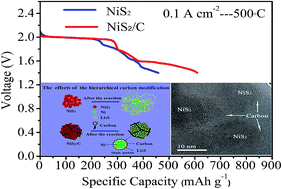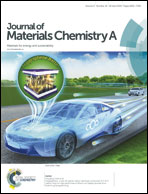A hierarchical carbon modified nano-NiS2 cathode with high thermal stability for a high energy thermal battery†
Abstract
Nanocrystallization is widely used to improve the discharge performances of LIBs. While its lower thermal stability limits the operating time, especially for the thermal battery system, which discharges at high temperatures (usually 500–550 °C). In this paper, NiS2 particles were coated with amorphous carbon. Then they accumulated into submicron particles and were connected/fixed by a carbon network. The initial decomposition temperature of nano-NiS2 increased from 400 °C to 590 °C after this hierarchical carbon modification. The hierarchical carbon modified nano-NiS2 cathode revealed excellent discharge performances in thermal batteries at high temperatures. Specifically with 0.1 A cm−2 at 500 °C, the specific capacity and energy reach 610 mA h g−1 and 1082 W h kg−1, respectively, at a cut-off voltage of 1.4 V. The specific energy retains about 503 W h kg−1 even at 700 °C. The multiple protective effects of hierarchical carbon modification not only effectively improve the conductivity and thermal stability, but also inhibit the dissolution and shuttling of products. So, hierarchical carbon modification makes nano-NiS2 more suitable for high specific energy and long operating life thermal batteries.



 Please wait while we load your content...
Please wait while we load your content...